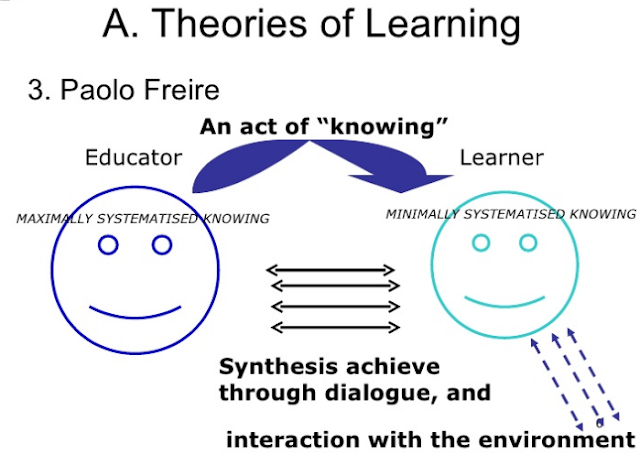Freire's model of learning as an "act of knowing" seems to suit an age gone by. In a previous post I explained this model from the late eighties and asked whether this pre digital technology model was sound, whether it still applied.
I also had a go at adapting it to fit a connectivist model in the last post - it felt somewhat trivial but it seemed to fit. I used the idea of an autonomous learner and the idea of "advanced systematised knowing", allowing learners to interact, to synthesise through dialogue and the environment, and thus to produce an act of knowing with a slightly more systematised level of knowing in the autonomous learners.
Here is the final diagram again from the original Freire (please note, it contains a bit I added on regarding the environment - this seemed to me to be essential to explain what actually happens):
So, the Educator with her maximised systematised knowing, through dialogue, achieved an "act of knowing" thus systematising the Learner's knowing a little more.
Can we replace the Educator with her textbook? Her digital resources? I think we can. In this way, the Learner can receive a non-face-to-face act of knowing and systematise her/his knowing a little more. But I would add that the outcome of this process is not predetermined, nor qualitatively predetermined.
The more systematised the knowing is in the learner the more likely that there will be understanding of the textbook/digital resource. The more autonomous the learner (in terms motivation, attitude and drive), the more likely that there will be a synthesis or an interaction with the environment and hence learning occur.
Could this mean that the learner's age will be a factor here? As might be the learner's stage of systematisation of knowing? Is it a necessary requirement for an Educator to be directly present face-to-face in these cases? What does this say about desirable learning in young children?
#change11


1 comment:
I understand Freire to have referred to the environment with a very specific and exacting role for the teacher. A Freirean dialogue requires a generative theme (http://www.freire.org/tag/generative-themes/) represented in a code (Freire often used drawings. The code represents the objective world and its significance to the learner. It forms a third point in the dialogue, and is the basis for meaningful and deep questionning and dialogue. The educator spends much time and effort to assemble a powerful code or reference point before the dialogue.
Post a Comment